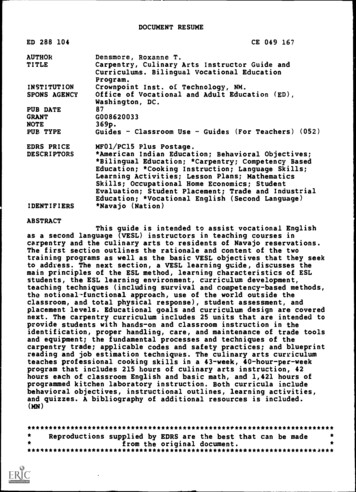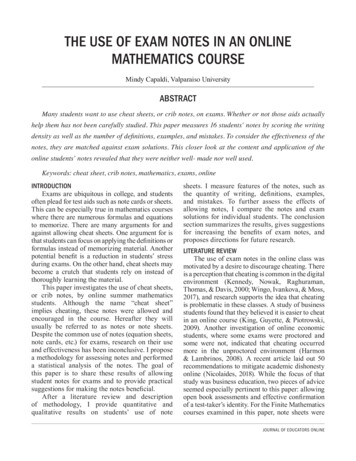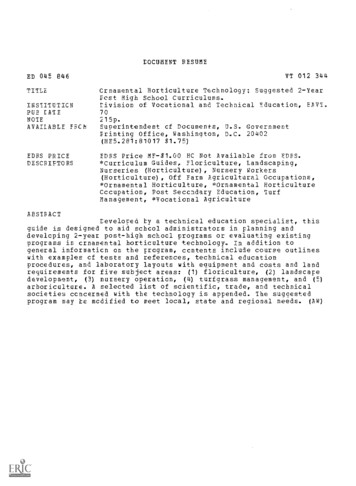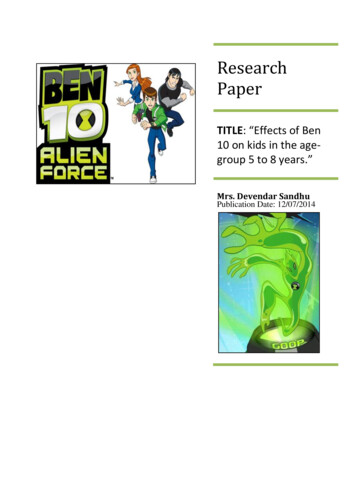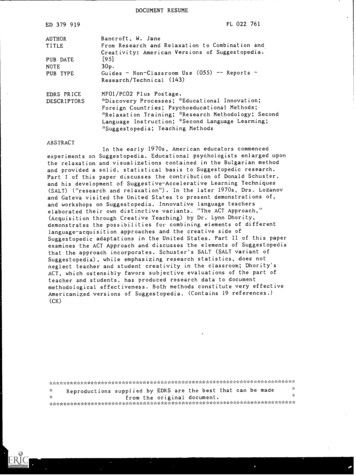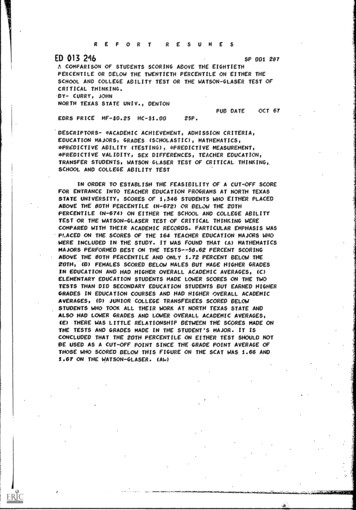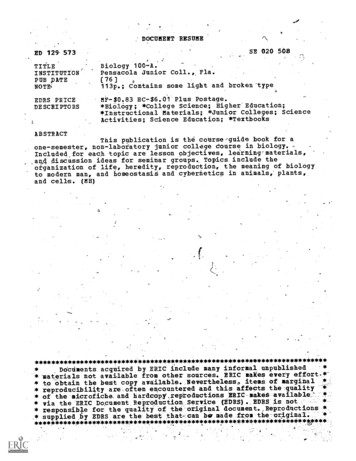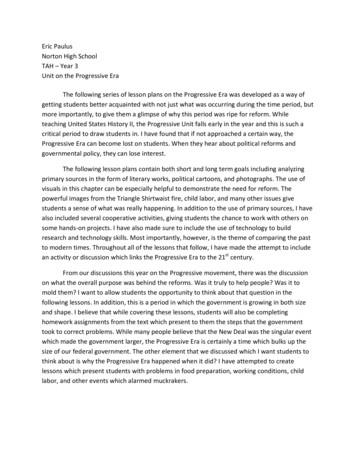
Transcription
Eric PaulusNorton High SchoolTAH – Year 3Unit on the Progressive EraThe following series of lesson plans on the Progressive Era was developed as a way ofgetting students better acquainted with not just what was occurring during the time period, butmore importantly, to give them a glimpse of why this period was ripe for reform. Whileteaching United States History II, the Progressive Unit falls early in the year and this is such acritical period to draw students in. I have found that if not approached a certain way, theProgressive Era can become lost on students. When they hear about political reforms andgovernmental policy, they can lose interest.The following lesson plans contain both short and long term goals including analyzingprimary sources in the form of literary works, political cartoons, and photographs. The use ofvisuals in this chapter can be especially helpful to demonstrate the need for reform. Thepowerful images from the Triangle Shirtwaist fire, child labor, and many other issues givestudents a sense of what was really happening. In addition to the use of primary sources, I havealso included several cooperative activities, giving students the chance to work with others onsome hands-on projects. I have also made sure to include the use of technology to buildresearch and technology skills. Most importantly, however, is the theme of comparing the pastto modern times. Throughout all of the lessons that follow, I have made the attempt to includean activity or discussion which links the Progressive Era to the 21st century.From our discussions this year on the Progressive movement, there was the discussionon what the overall purpose was behind the reforms. Was it truly to help people? Was it tomold them? I want to allow students the opportunity to think about that question in thefollowing lessons. In addition, this is a period in which the government is growing in both sizeand shape. I believe that while covering these lessons, students will also be completinghomework assignments from the text which present to them the steps that the governmenttook to correct problems. While many people believe that the New Deal was the singular eventwhich made the government larger, the Progressive Era is certainly a time which bulks up thesize of our federal government. The other element that we discussed which I want students tothink about is why the Progressive Era happened when it did? I have attempted to createlessons which present students with problems in food preparation, working conditions, childlabor, and other events which alarmed muckrakers.
Subject: United States History II – Progressive ReformsGrade: 11th GradeLevel: College PrepTime: 1 Class PeriodObjectives:1. Students will define the term “progressive” in terms of the Progressive Era2. Students will explain how The Jungle led to the passage of progressive reform legislationCurriculum Framework Standards:1. USII.8.E – Analyze the origins of Progressivism and important Progressive leaders, andsummarize the major accomplishments of ProgressivismPeopleA.B.C.D.E.F.G.H.I.Jane AddamsWilliam Jennings BryanJohn DeweyRobert La FollettePresident Theodore RooseveltUpton SinclairPresident William H. TaftIda TarbellPresident Woodrow WilsonPoliciesA. bans against child laborB. the initiative referendum and its recallC. the Sherman Anti-Trust Act (1890)D. the Pure Food and Drug Act (1906)E. the Meat Packing Act (1906)F. the Federal Reserve Act (1913)G. the Clayton Anti-Trust Act (1914)H. the ratification of the Nineteenth Amendment in 19201. Preparation & Planning: The word “Progressive” will be printed on the white board asstudents walk into the class. Once the period begins, students will be asked, in their ownwords, to define the term. In a “think-pair-share” activity, students will be given a momentto compare their answer with a partner sitting next to them. Each pair will then have aminute to refine their answer and share their response with the class. Once finished, theclass will agree on a working definition.
2. Assistance & Associations: Before students break out into groups, they will be asked toexplain how comfortable they feel when they buy a consumer product. How do they know itis safe for consumption? Can they think of an instance when they have been dissatisfied?Following this activity, students will work in groups of 2-3 and read the attached excerptfrom Upton Sinclair’s The Jungle. Once completed, students will complete the discussionquestions and return for a full class discussion to recap what they have read.3. Reflection & Readiness: In a ticket-to-leave activity, students will be asked to reflect on howthe work of Upton Sinclair still impacts us in the 21st century. Is his work still important andinfluential today? Why or why not?
The JungleUpton Sinclair. . . And then there was the condemned meat industry, with its endless horrors. Thepeople of Chicago saw the government inspectors in Packingtown, and they all tookthat to mean that they were protected from diseased meat; they did not understandthat these hundred and sixty-three inspectors had been appointed at the request of thepackers, and that they were paid by the United States government to certify that allthe diseased meat was kept in the state. They had no authority beyond that; for theinspection of meat to be sold in the city and state the whole force in Packingtownconsisted of three henchmen of the local political machine! . . .And then there was "potted game" and "potted grouse," "potted ham," and "deviledham"—devyled, as the men called it. "De-vyled" ham was made out of the waste endsof smoked beef that were too small to be sliced by the machines; and also tripe, dyedwith chemicals so that it would not show white, and trimmings of hams and cornedbeef, and potatoes, skins and all, and finally the hard cartilaginous gullets of beef,after the tongues had been cut out. All this ingenious mixture was ground up andflavored with spices to make it taste like something. Anybody who could invent anew imitation had been sure of a fortune from old Durham, said Jurgis's informant,but it was hard to think of anything new in a place where so many sharp wits hadbeen at work for so long; where men welcomed tuberculosis in the cattle they werefeeding, because it made them fatten more quickly; and where they bought up all theold rancid butter left over in the grocery stores of a continent, and "oxidized" it by aforced-air process, to take away the odor, rechurned it with skim milk, and sold it inbricks in the cities! . . .There was never the least attention paid to what was cut up for sausage; there wouldcome all the way back from Europe old sausage that had been rejected, and that wasmouldy and white—it would be dosed with borax and glycerine, and dumped into thehoppers, and made over again for home consumption. There would be meat that hadtumbled out on the floor, in the dirt and sawdust, where the workers had tramped andspit uncounted billions of consumption germs. There would be meat stored in greatpiles in rooms; and the water from leaky roofs would drip over it, and thousands ofrats would race about on it. It was too dark in these storage places to see well, but aman could run his hand over these piles of meat and sweep off handfuls of the drieddung of rats. These rats were nuisances, and the packers would put poisoned breadout for them, they would die, and then rats, bread, and meat would go into thehoppers together. This is no fairy story and no joke; the meat would be shovelled intocarts, and the man who did the shoveling would not trouble to lift out a rat even whenhe saw one—there were things that went into the sausage in comparison with which apoisoned rat was a tidbit. There was no place for the men to wash their hands beforethey ate their dinner, and so they made a practice of washing them in the water thatwas to be ladled into the sausage. There were the butt-ends of smoked meat, and thescraps of corned beef, and all the odds and ends of the waste of the plants, that wouldbe dumped into old barrels in the cellar and left there. Under the system of rigid
economy which the packers enforced, there were some jobs that it only paid to doonce in a long time, and among these was the cleaning out of the waste barrels. Everyspring they did it; and in the barrels would be dirt and rust and old nails and stalewater—and cart load after cart load of it would be taken up and dumped into thehoppers with fresh meat, and sent out to the public's breakfast. Some of it they wouldmake into "smoked" sausage—but as the smoking took time, and was thereforeexpensive, they would call upon their chemistry department, and preserve it withborax and color it with gelatine to make it brown. All of their sausage came out of thesame bowl, but when they came to wrap it they would stamp some of it "special," andfor this they would charge two cents more a pound. . . .Discussion Questions:1. List 3 activities taking place in the meat factory which would be considered unsafe or unlawful.2. How did you feel when you read about these activities?3. Do you believe things like this happen in food preparation today? Why or why not?4. What do you think Sinclair’s purpose was in writing The Jungle? How do you think peoplereacted after reading it?5. From your textbook, define The Pure Food & Drug Act and the Meat Inspection Act of 1906.How influential do you feel Upton Sinclair was in the passing of this legislation?
Subject: United States History II – Triangle Shirtwaist FireGrade: 11th GradeLevel: College PrepTime: 1 Class PeriodObjectives:3. Students will identify the major causes of the Triangle Shirtwaist fire4. Students will compare and contrast labor conditions in the early 20th century with presentday working conditions5. Students will analyze a photograph and political cartoonCurriculum Framework Standards:2. USII.8.E – Analyze the origins of Progressivism and important Progressive leaders, andsummarize the major accomplishments of Progressivism4. Preparation & Planning: Students will complete an image analysis worksheet from a photoof the Triangle Shirtwaist fire. Students will identify the limited visual information in thephoto to make inferences for what they believe is taking place. Once finished, student willshare their inferences for what they believe is taking place.5. Assistance & Associations: Following the image analysis, students will do a round-robinstyle reading activity in which the story of the Triangle Shirtwaist Fire will be revealed. Eachstudents will read aloud a paragraph from the excerpt. Additional photographs will then bedisplayed on the in-focus.Students will then get into groups of approximately 3 students (depending on class size) fora political cartoon activity. Each group will be given a political cartoon from the TriangleShirtwaist fire for analysis. Each group will complete a Political Cartoon Analysis form fortheir cartoon. Once complete, each group will share their cartoon with the class and discusstheir thoughts on the meaning behind the cartoon.6. Reflection & Readiness: Students will complete an exit slip in which they will identify 3reasons why the fire occurred along with 3 modern day safety procedures which help toprevent such disasters from happening today.
The Story of the FireNear closing time on Saturday afternoon, March 25, 1911, a fire broke out on thetop floors of the Asch Building in the Triangle Waist Company. Within minutes, thequiet spring afternoon erupted into madness, a terrifying moment in time, disruptingforever the lives of young workers. By the time the fire was over, 146 of the 500 employeeshad died. The survivors were left to live and relive those agonizing moments. The victimsand their families, the people passing by who witnessed the desperate leaps from ninth floorwindows, and the City of New York would never be the same.Survivors recounted the horrors they had to endure, and passers-by and reporters also toldstories of pain and terror they had witnessed. The images of death were seared deeply intheir mind's eyes.Many of the Triangle factory workers were women, some as young as 15 years old.They were, for the most part, recent Italian and European Jewish immigrants who had cometo the United States with their families to seek a better life. Instead, they faced lives ofgrinding poverty and horrifying working conditions. As recent immigrants struggling with anew language and culture, the working poor were ready victims for the factory owners. Forthese workers, speaking out could end with the loss of desperately needed jobs, a prospectthat forced them to endure personal indignities and severe exploitation. Some turned tolabor unions to speak for them; many more struggled alone. The Triangle Factory was anon-union shop, although some of its workers had joined the International Ladies' GarmentWorkers' Union.New York City, with its tenements and loft factories, had witnessed a growingconcern for issues of health and safety in the early years of the 20th century.Groups such as the International Ladies' Garment Workers' Union (ILGWU) and theWomens' Trade Union League (WTUL) fought for better working conditions and protectivelegislation. The Triangle Fire tragically illustrated that fire inspections and precautions werewoefully inadequate at the time. Workers recounted their helpless efforts to open the ninthfloor doors to the Washington Place stairs. They and many others afterwards believed theywere deliberately locked-- owners had frequently locked the exit doors in the past, claimingthat workers stole materials. For all practical purposes, the ninth floor fire escape in theAsch Building led nowhere, certainly not to safety, and it bent under the weight of thefactory workers trying to escape the inferno. Others waited at the windows for the rescueworkers only to discover that the firefighters' ladders were several stories too short and thewater from the hoses could not reach the top floors. Many chose to jump to their deathsrather than to burn alive.
The Next DayIn the weeks that followed, the grieving city identified the dead, sorted out theirbelongings, and reeled in numbed grief at the atrocity that could have been averted with afew precautions. The International Ladies' Garment Workers' Union proposed an official dayof mourning. The grief-stricken city gathered in churches, synagogues, and finally, in thestreets.Protesting voices arose, bewildered and angry at the lack of concern and the greedthat had made this possible. The people demanded restitution, justice, and action thatwould safeguard the vulnerable and the oppressed. Outraged cries calling for action toimprove the unsafe conditions in workshops could be heard from every quarter, from themainstream conservative to the progressive and union press.Workers flocked to union quarters to offer testimonies, support mobilization, and demandthat Triangle owners Harris and Blanck be brought to trial. The role that strong unions couldhave in helping prevent such tragedies became clear. Workers organized in powerful unionswould be more conscious of their rights and better able to obtain safe working conditions.InvestigationLocal 25 of the ILGWU organized a rally against the unsafe working conditionsthat led to the disaster. Meanwhile the Women's Trade Union League led a campaign toinvestigate such conditions among Triangle workers, to collect testimonies, and to promotean investigation. Within a month of the fire the governor of New York State appointed theFactory Investigating Commission. For five years, this commission conducted a series ofstatewide hearings that resulted in the passage of important factory safety legislation.Frances Perkins, later to become Secretary of Labor under President Franklin DelanoRoosevelt, watched the Asch Building burn, an event that influenced her decision to becomea lifelong advocate for workers. Perkins assisted in the factory investigation from herposition as executive secretary of the New York Committee on Safety.Labor and management in the garment trades cooperated in the ongoing work ofthe Joint Board of Sanitary Control to set and maintain standards of sanitation inthe workplace. This board, consisting of representatives from the clothing industry andfrom the union, was established a year prior to the Triangle Fire in the aftermath of the1910 Cloakmakers' Strike. It conducted its own investigations and continued to inspect andmonitor health and safety conditions. It set sanitary standards exceeding the legalrequirements and, because the manufacturers' association and the union had jointlyapproved the standards, was able to enforce those standards in the shops that it monitored.
The ILGWU, in concert with others in the labor movement and progressiveorganizations, would continue a long and difficult battle to achieve the right ofworkers to safe, decent working conditions. The event, as it faded from immediatepublic outrage, was not forgotten nor was it isolated in the course of the history of Americanworkers. It did point out the many serious problems facing factory workers and paved theway for attempts at remedies through protective legislation. In the immediate yearsfollowing the fire, a flurry of legislation perfected old laws or introduced new ones, whichsomewhat improved working conditions.Justice?Eight months after the fire, a jury acquitted Blanck and Harris, the factory owners,of any wrong doing. The task of the jurors had been to determine whether the ownersknew that the doors were locked at the time of the fire.Customarily, the only way out for workers at quitting time was through an opening on theGreen Street side, where all pocketbooks were inspected to prevent stealing. Worker afterworker testified to their inability to open the doors to their only viable escape route ? thestairs to the Washington Place exit, because the Greene Street side stairs were completelyengulfed by fire. More testimony supported this fact. Yet the brilliant defense attorney MaxSteuer planted enough doubt in the jurors' minds to win a not-guilty verdict. Grievingfamilies and much of the public felt that justice had not been done. "Justice!" they cried."Where is justice?"Twenty-three individual civil suits were brought against the owners of the Aschbuilding. On March 11, 1913, three years after the fire, Harris and Blanck settled.They paid 75 dollars per life lost.
Photo Analysis WorksheetStep 1. ObservationA.Study the photograph for 2 minutes. Form an overall impression of the photograph and thenexamine individual items. Next, divide the photo into quadrants and study each section to seewhat new details become visible.B.Use the chart below to list people, objects, and activities in the photograph.PeopleObjectsActivitiesStep 2. InferenceBased on what you have observed above, list three things you might infer from thisphotograph.Step 3. QuestionsWhat questions does this photograph raise in your mind?
Cartoon Analysis WorksheetLevel 1Visuals1.Words (not all cartoons include words)List the objects or people you see in the1.Identify the cartoon caption and/or title.2.Locate three words or phrases used bycartoon.the cartoonist to identify objects orpeople within the cartoon.3.Record any important dates or numbersthat appear in the cartoon.Level 2Visuals2.3.WordsWhich of the objects on your list are4.Which words or phrases in the cartoonsymbols?appear to be the most significant? WhyWhat do you think each symbol means?do you think so?5.List adjectives that describe the emotionsportrayed in the cartoon.Level 3A. Describe the action taking place in the cartoon.B. Explain how the words in the cartoon clarify the symbols.C. Explain the message of the cartoon.D. What special interest groups would agree/disagree with the cartoon's message? Why?
Subject: United States History II – Suffrage ArgumentsGrade: 11th GradeLevel: Honors and Level 1Time: 2 Class PeriodsObject
The following lesson plans contain both short and long term goals including analyzing primary sources in the form of literary works, political cartoons, and photographs. The use of visuals in this chapter can be e




